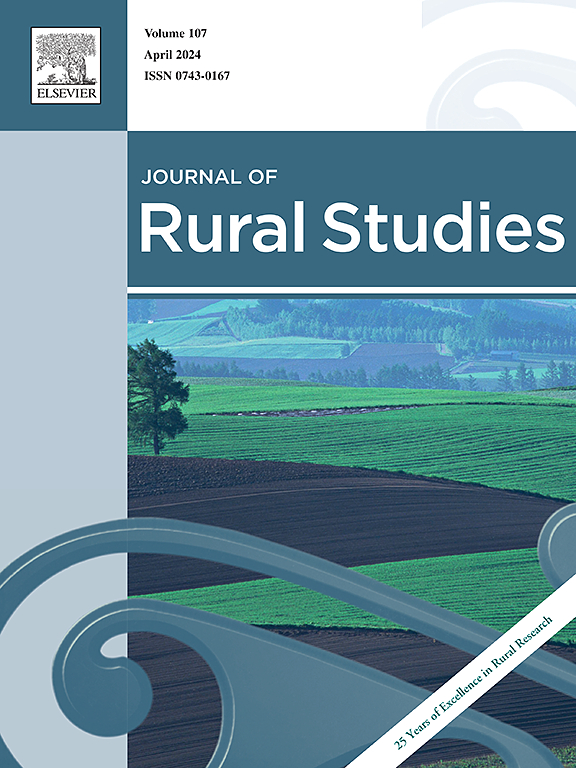Characteristics and optimization strategies of multi-subject governance network structure for land consolidation
IF 5.1
1区 社会学
Q1 GEOGRAPHY
引用次数: 0
Abstract
Land consolidation is an essential means to promote rural revitalization. Diversified governance subjects characterize land consolidation, and these subjects are interdependent in their work tasks and gradually form a multi-subject governance network. Effectively configuring a reasonably structured multi-subject governance network for land consolidation is crucial for improving the governance effect of land consolidation and thus promoting rural revitalization. This study constructs the multi-subject governance network for land consolidation from the perspective of a power-interest-trust relationship. Taking the pilot project of comprehensive land consolidation in Hubei Province, China, as the study case, this study analyzes the structural characteristics of the multi-subject governance network for land consolidation using the social network analysis method. The exponential random graph models are used to systematically identify the driving factors of network relationship formation, based on which targeted network structure optimization strategies are proposed. The results show that the multi-subject governance network for land consolidation is generally in a low-level and unbalanced development stage, that this network has overall looseness, local relevance, and significant small-world characteristics, and that the cohesive subgroups of this network exhibit obvious differences in relevance. In addition, this network has prominent core-periphery structure characteristics, and it is constrained by a few core nodes, such as government organizations and implementation enterprises, with most nodes, such as rural communities, financial institutions, and research institutions, at the edge of the network. Based on the above network structure characteristics and the influencing factors of network relationship formation, this study proposes network structure optimization strategies from overall optimization and node optimization. This study can provide theoretical insights and decision-making references for rationally configuring the multi-subject governance network structure of land consolidation, enhancing the governance effectiveness of land consolidation, and then boosting rural revitalization. Meanwhile, it also provides Chinese experience and reference for other developing countries to establish a multi-subject collaborative governance mode of land consolidation.
土地整理多主体治理网络结构的特征与优化策略
土地整理是推动乡村振兴的重要手段。土地整理具有治理主体多元化的特点,这些主体在工作任务中相互依存,逐步形成了多主体治理网络。有效配置结构合理的土地整理多主体治理网络,对于提升土地整理的治理效果,进而推动乡村振兴至关重要。本研究从权力-利益-信任关系的视角构建土地整理的多主体治理网络。本研究以中国湖北省土地综合整理试点项目为研究案例,运用社会网络分析方法分析了土地整理多主体治理网络的结构特征。利用指数随机图模型系统识别了网络关系形成的驱动因素,在此基础上提出了有针对性的网络结构优化策略。结果表明,土地整理多主体治理网络总体上处于低水平、不平衡的发展阶段,该网络具有整体松散性、局部相关性和显著的小世界特征,该网络的内聚子群在相关性上表现出明显的差异。此外,该网络具有突出的核心-边缘结构特征,受政府组织、实施企业等少数核心节点制约,农村社区、金融机构、研究机构等多数节点处于网络边缘。基于上述网络结构特点和网络关系形成的影响因素,本研究从整体优化和节点优化两个方面提出了网络结构优化策略。本研究可为合理配置土地整理多主体治理网络结构,提升土地整理治理成效,进而助力乡村振兴提供理论启示和决策参考。同时,也为其他发展中国家建立土地整理多主体协同治理模式提供了中国经验和借鉴。
本文章由计算机程序翻译,如有差异,请以英文原文为准。
求助全文
约1分钟内获得全文
求助全文
来源期刊

Journal of Rural Studies
Multiple-
CiteScore
9.80
自引率
9.80%
发文量
286
期刊介绍:
The Journal of Rural Studies publishes research articles relating to such rural issues as society, demography, housing, employment, transport, services, land-use, recreation, agriculture and conservation. The focus is on those areas encompassing extensive land-use, with small-scale and diffuse settlement patterns and communities linked into the surrounding landscape and milieux. Particular emphasis will be given to aspects of planning policy and management. The journal is international and interdisciplinary in scope and content.
 求助内容:
求助内容: 应助结果提醒方式:
应助结果提醒方式:


